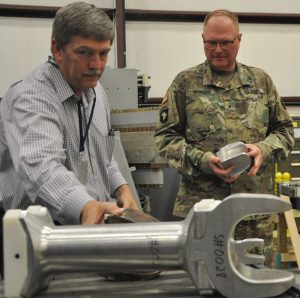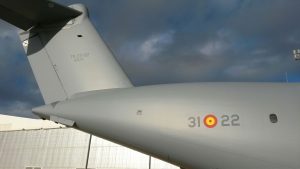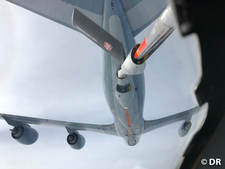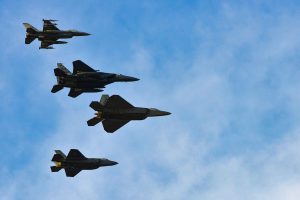2017-12-30 By Robbin Laird
My wife is French and I have spent a good deal of my professional life dealing with European security and defense issues.
I have lived through several phases almost ages of European-American relations and have travelled widely in Europe, and the Soviet Union over the past thirty years.
With Carter, you had Brzezinski and Brown leading the effort to rework a nuclear war fighting strategy against the Soviets. This was a shock to most European governments which really did not want to think about the nuclear challenges posed by the Soviets.
Next entered Ronald Reagan, an actor who was a life time anti-communist and very much focused on dealing with the Soviet Union and ending its existence as the “evil empire.” The battle of Euromissiles was a key axis of conflict in the early 1980s. The initial reactions of most Europeans was disdain for Reagan as an intellectual lightweight who did not understand global politics.
I travelled Europe during the Euromissile crisis and argued the case for nuclear modernization against a widespread negative opinion about nuclear weapons held in Germany and elsewhere
With the election if the first President Bush, the reunification of Germany came onto the agenda, an effort on which I worked a great deal.
It was clear that virtually no European leader or many elites supported German unification, in part because of what they expected to be the Soviet backlash.
Next up was George W. Bush and dealing with the 9/11 attack and then invading Iraq.
Despite significant warnings that taking down Saddam Hussein would leave a power vacuum, George W. Bush went ahead anyway. The US reaction to Europeans not supporting the invasion was extremely negative with silly things like renaming French fries Freedom Fries.
After the US and the allies involved in the Iraq War worked through several years of dealing with the Afghan situation as well, the defense side was in full engagement for fighting land wars, and reduced significantly the support for air and naval modernization.
Then came President Obama, the “toastmaster in chief” who was lionized throughout his presidency in ways that made him virtually more of a European than an American President.
He extended the role of the regulatory state, and travelled globally resetting the US image by often apologizing for went before.
He put in place red lines which he did not enforce, failed to respond to the Crimean crisis and set in motion Putin unleashed.
He negotiated a deal on Iran nuclear weapons which did little to deal with the increasingly aggressive behavior of Iran and in the words of one senior UAE official: “the agreement became more important to make and protect than dealing with the increasingly aggressive behavior of Iran, which in any case has wide latitude to become a nuclear power down the road.”
Enter President Trump, an event that was not supposed to happen.
Because this was not to happen, the high priests of strategy in Washington and Brussels did not see a real need to prepare for plan B.
 The Trump campaign was of interest simply showing the strange culture the Americans outside of Washington (except for California and New York) seem to pursue.
The Trump campaign was of interest simply showing the strange culture the Americans outside of Washington (except for California and New York) seem to pursue.
In part, the election of Trump exposed the general lack of knowledge many Europeans have about the Untied States and about the politics and economics of the United States. The US is a federal system and one in which in electing its President the role of the electoral college reflects a federal rather than a national system.
So when Trump won a majority of electoral votes while Mrs. Clinton won a majority of popular vote, there were many articles in the European press that expressed dismay against what was viewed as almost an illegal election.
Then the Russian factor folded in and the various opponents of Trump focused on Russian cyber engagements as some sort of strategic surprise and launched a continuous and ongoing campaign that somehow Trump is a compromised President simply by some of his folks having dealings with the Russians.
Trump’s style is one of shock and awe with regard to the political system and has without any doubt stunned allies of the Untied States who expect not only a different style but a different handling by the US government of allies.
And in a shocking development, Trump ended up focusing on what he thought was in the US interests, not some vague and amorphous globalization agenda, an agenda which at least one major adversary of the United States, the PRC, is working any way they can to their global advantage.
When one travels in Europe one hears mostly negative comments about the President and his style, but very little focus on what the President might actually be doing and even more to the point, simply neglecting what global adversaries of the liberal democracies are about as they work their interpretation of globalization.
This is a problem because Trump loves to shape a saga via his shock and awe tactics, and play off oft the responses to his shock and awe and then he shapes his real politics.
He could be a Viking in this sense.
This does not make for an easy interaction with the Administration, but given the significance of both the economy and strategic power the United States provides for the liberal democracies,it is an evolving narrative which needs to be understand, and interactively shaped.
To give one a sense of how the European press works the Trump Administration, the new tax law is interpreted by a number of continental newspapers as being anti-European because it will draw investments into the United States.
Of course, Brexit plus the new US tax laws might well have a negative impact on European inward investment, but here is a radical idea: how about lowering tax rates in Europe?
But this is much too Trumpian for a number of European analysts.
I started the year by being in Norway at a conference (ironically at a major Viking settlement) and heard an amazing diatribe passing as analysts of the Trump challenge to Europe.
Besides being lectured on European values and the long history of Germany democracy, this German speaker decided to argue de facto for the rise of a threatening type of populism in the United States which would undercut liberal democracy.
Trump would not comply with the rule of law and because Republicans controlled the Congress and most the states, the wave of anti-liberal and anti-democratic populism would wash away the US ally that Europe once knew.
Trump would attack the EU and rip apart NATO and shape an isolationist US agenda.
It was somewhat difficult to listen to this and my comment to a number of Norwegian officers was that I promised that we would not invade the Sudetenland.
A more measured look at the challenges was provided by the then Norwegian defense minister who is now the foreign minister who underscored the challenges but expected a solid working relationship with both Brexit Britain and Trump America.
I am pleased that recent dialogue with, and statements from, the new US administration emphasize US commitment to NATO and transatlantic security. But at the same time, there is still much we do not know about President Trump’s foreign and security policy.
While I don’t think we should exaggerate the significance of Russian influence, we shouldn’t underestimate it either. In any case, we need to pay close attention to what is going on in our own countries now. Because these underlying currents in many countries may also undermine international defense and security cooperation at a time when the need for cooperation is greater than in a very long time.
The security challenges that we are all facing from violent extremism, a more assertive and destabilizing Russia and the consequences of conflict and instability in North Africa and the Middle East, requires more trust and closer collaboration, not the opposite.
And given the current situation, one of my greatest concerns is that our ability to make decisions in NATO or the EU will be challenged.
It is clear that President Trump’s style and some of his statements can give pause, but it remains as always what is the reality of what is going on in the United States which after all is a bigger entity than any one President.
What bothers me and bothers me deeply is the unwillingness to do analysis rather than simply to justify whatever one’s own particular views are.

Certainly, the President has focused on the North Korean threat directly in a way earlier Administration’s simply ignored. His work with the Saudi government and the UAE might yield significant breakthroughs in the Middle East. His efforts to refocus US forces on meeting the high end threat are clearly a work in progress, but at least there is a work in progress.
And underlying all this is a clear effort to grow the American economy and to deal with strategic challenges in a broader manner than the last two administrations.
With a significant European crisis underway with Brexit, Poland and its dynamics, Spain and its separatist agenda, the absence of a new government in Germany, and general uncertainty about the new phase of European development, having a President like Trump is a useful foil for internal European debates.
Clearly, the shift from Obama to Trump has been a shock to the European system which when coupled with the new Russian threats and Brexit as well as other internal dynamics raise fundamental questions about the shape of Europe over the next decade and what kind of America will be its ally.
One European analyst recently contrasted, the shift from Obama to Trump as follows:
The switch in the US from Nobel laureate and first black president, Obama, to Trump, a billionaire populist who tweets fake news and insults, and defends white supremacists, could hardly have been more extreme.
This analyst started his article with the broad point that a year into the Trump Administration “the foundations of the transatlantic relationship are still intact.”
https://euobserver.com/europe-in-review/139870
One might ask why?
And the answer has nothing to do with Trump but rather to the forces both within and without his Administration resisting Trumpism.
We learn that NATO is doing well and why?
US military chiefs have repeatedly pledged their commitment to Nato. The US is also leading a Nato battalion in Poland to deter Russian aggression.
In effect, there seems to have been a military coup d’erat in the United States marginalizing the President.
It could have nothing to do with Trump’s actual policies as opposed to a tweet.
 In a way Trump creates this problem for himself, but it is also his still of fomenting change.
In a way Trump creates this problem for himself, but it is also his still of fomenting change.
He uses shock and awe as a means to an end — reform of American policies in a fundamental sense.
What remains to be seen will be the results at the end of the day of his efforts.
If the United States and its ability to support allies is enhanced under the Trump Administration as opposed the obvious weaknesses of the United States evident to Americans fostered by the “Nobel laureate,” the challenges will be worth it from the standpoint of many Americans.
But according to a European diplomat, the effort is not worth focusing upon because the United States is already the “weakest” state in the Western Alliance.
In what could only be labeled as values based analysis, here is what this European diplomat had to say:
Speaking to EUobserver on condition of anonymity, one senior EU diplomat said Trump’s antics were no laughing matter.
“The biggest danger for Europe is a paralysis with regard to the question of Russia … the US is emerging as the weakest point of the Western alliance,” he said.
To be clear, this is a values based judgment in which the European diplomat sees the US under Trump deviating from the path on which it ought to be following; but as a statement of fact, it is hardly correct, unless one believes that the US economic and military power, let alone the continuing cultural attraction of the United States is of no consequence.
And with the forceful coming of the Second Nuclear Age, Europe like the United States faces some rather unpleasant realities of the return of the nuclear problem. and one not solved by earlier equations of nuclear deterrence.



 The 31st Air Wing is based at Zaragoza Air Base located 16 kilometres (10 mi) west of Zaragoza, 270 km (168 mi) west of
The 31st Air Wing is based at Zaragoza Air Base located 16 kilometres (10 mi) west of Zaragoza, 270 km (168 mi) west of  The mission was in support of providing a protective air bubble for the launch of an Ariane rocket.
The mission was in support of providing a protective air bubble for the launch of an Ariane rocket.
 Four U.S. Air Force fighter jets practice the inauguration flyover at Joint Base Langley-Eustis, Va., Jan. 19, 2017. The formation is comprised of two, fourth generation fighters (F-15 and F-16) along with two, fifth generation fighters (F-22 and F-35). (U.S. Air Force photo by Airman 1st Class Tristan Biese) (Photo by Airman 1st Class Tristan Biese)
Four U.S. Air Force fighter jets practice the inauguration flyover at Joint Base Langley-Eustis, Va., Jan. 19, 2017. The formation is comprised of two, fourth generation fighters (F-15 and F-16) along with two, fifth generation fighters (F-22 and F-35). (U.S. Air Force photo by Airman 1st Class Tristan Biese) (Photo by Airman 1st Class Tristan Biese) During my visit on September 25, 2017, I had a chance to tour the factory with Don Kinard, an F-35 manufacturing expert.
During my visit on September 25, 2017, I had a chance to tour the factory with Don Kinard, an F-35 manufacturing expert.